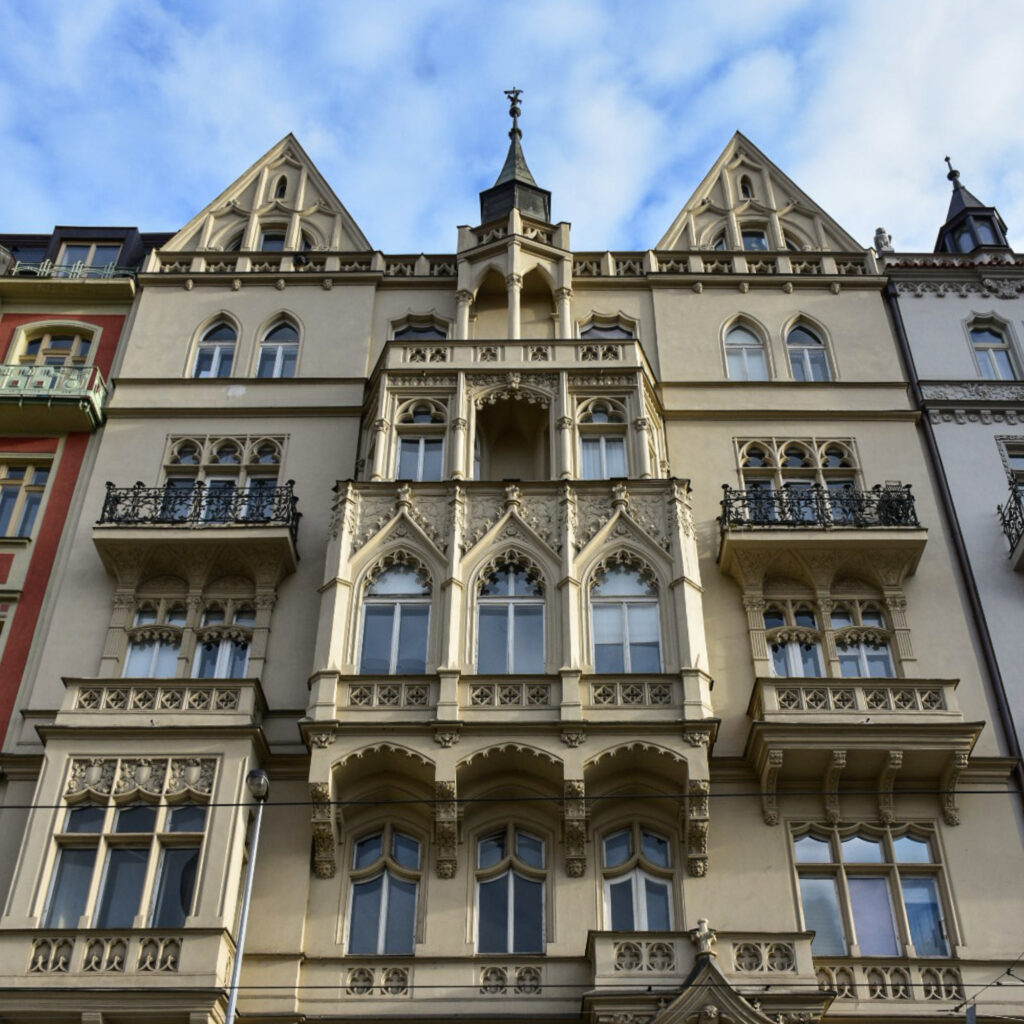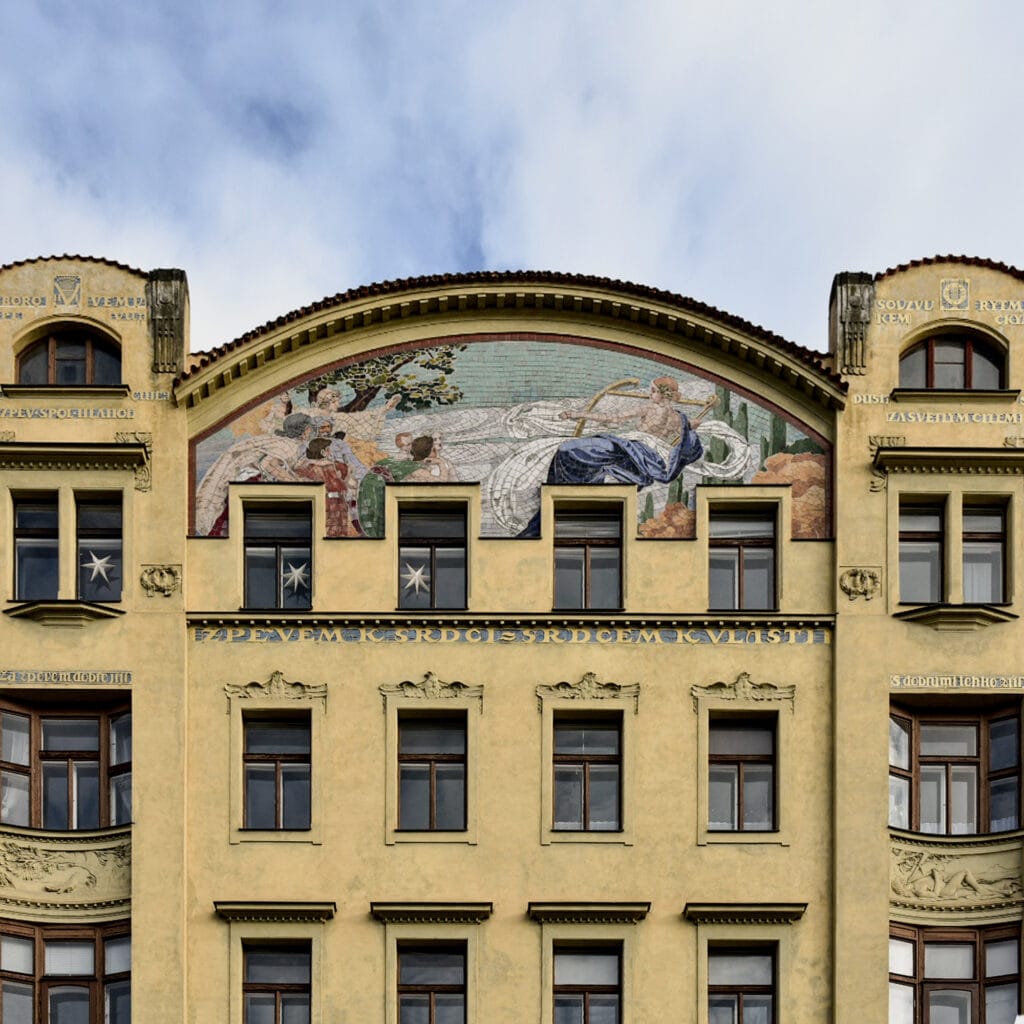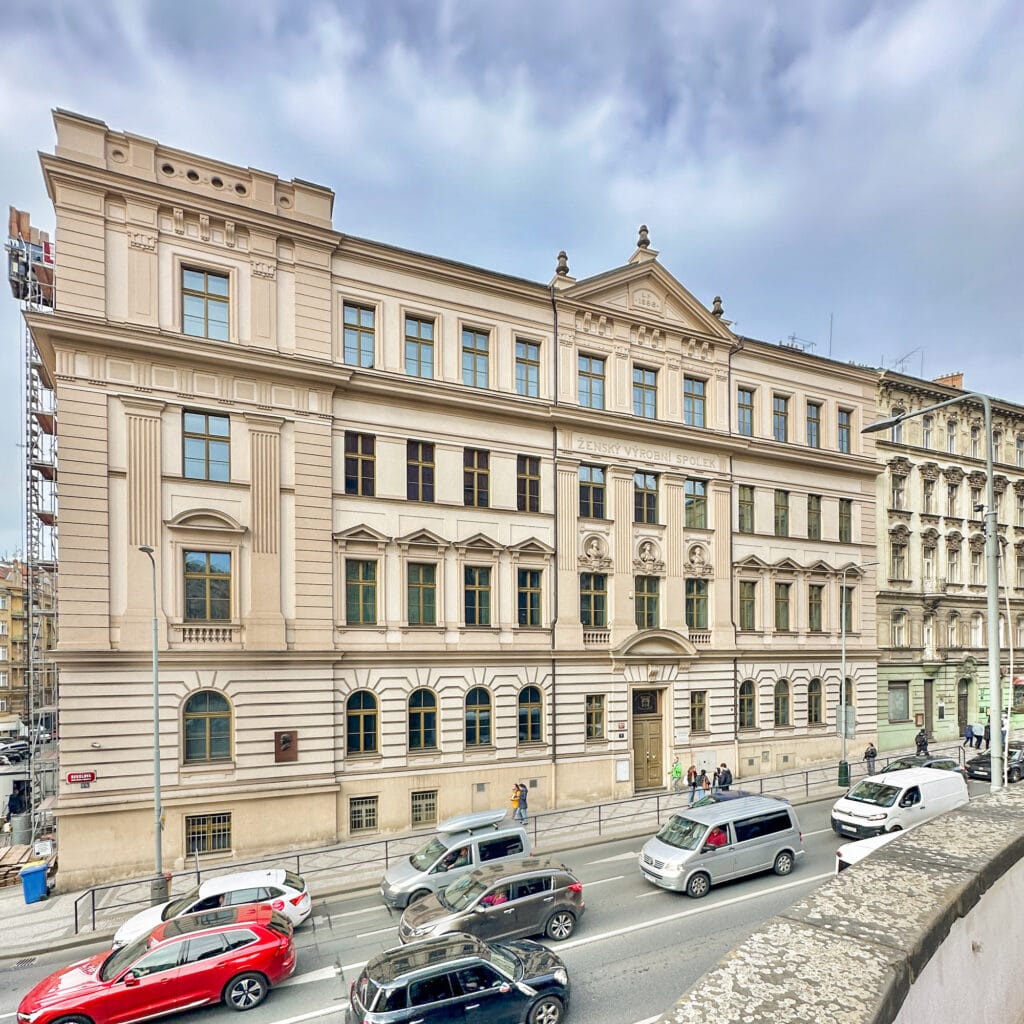Feminist route
How Czech women changed Prague
A walk with the subtheme of feminism will take you to places associated with women’s emancipation and education in our country. Each stop represents the journey of Czech women toward the right to vote, study, have fun, or generally make decisions about their lives. Discover the stories of feminists, architects, or writers who, with their perseverance, transformed social norms. We can expect a journey from the struggles for women’s rights to modern expressions of political, economic, and social equality.

Duration:
1 hour
Number of stops:
8
Lenght:
3,7 km
MHD start:
Jiráskovo náměstí
MHD end:
Jiráskovo náměstí
Jiřina Šiklová library
Architect: František Jiskra
Year of completion: 1906
The tenement houses on Masaryk Embankment are undoubtedly one of the architectural treasures of Prague. In our case, a beautiful, neo-Gothic-inspired house number 8 is a jewelry box hiding a real treasure. We are talking about a library that boasts the largest collection of feminist and gender literature in Central and Eastern Europe. It was founded in 1992 in the apartment of sociologist, dissident, and founder of the Department of Social Work and Gender Studies, Jiřina Šiklová, when initially it was just her private collection. Over time, the library acquired valuable publications from individual donors, laying the foundation for its future archive. Today, the library offers a diverse range of books and magazines focused on gender stereotypes, discrimination, feminism, gender, and queer studies. It also houses the archive of Eliška Krásnohorská, which provides the public with valuable archival documents from the history of the Czech women’s movement.

The Hlahol Association house
Architect: Josef Fanta, František Schlaffer
Year of completion: 1905
An important place on the feminist map of Prague is the Hlahol Association house, which was established as the new headquarters of this mixed choir. The first meeting of active women in the Czech women’s movement, led by Karla Máchová (a Czech politician and writer), occurred here. It was also the first celebration associated with International Women’s Day, then called International Day for Women’s Suffrage. The association house consists of three interconnected parts: tenement houses leading to Masaryk Embankment and Vojtěšská Street, and a connecting neck inserted into the inner block between the two houses. The author of the initial designs was František Schlaffer, a member of Hlahol. However, the construction was ultimately completed by Josef Fanta, who brought together renowned names from that time’s artistic scene. The early Secessionist facade stands out with its sculptural decoration by Josef Pekárek and ornamental patterns by Karel Mottl.

Grammar school Minerva
Architect: Jan Voráček
Year of completion: 1906
In the close vicinity of the Church of St. Adalbert in New Town, you can find the Pštrossova Elementary Art School. Although the unassuming corner building has been used for teaching singing and dancing since the 1990s, its history is most commonly associated with the first girls’ gymnasium in Austria-Hungary, Gymnázium Minerva. Discussions about establishing a public girls’ school with secondary education leading to university education have been ongoing since the early years of the first half of the 19th century. However, the idea took concrete shape in 1890 with the so-called Petition of Czech Women to the Imperial Council, which included attachments on establishing a state girls’ gymnasium and women’s studies at the philosophical and medical faculties. Then, the publication of the Manifesto followed: For Czech Education, and in the same year, education at Minerva was launched, initially only in two rooms in the above building near the Church of St. Adalbert.

The birth house of Karolina Světlá
Architect: is not known
Year of completion: renaissance, baroque reconstruction in the 1st quarter of the 18th century
Karolína Světlá was one of the most famous Czech writers and a significant feminist. In her works, she focused on social issues, moral values, and the position of women in society. She wrote several works set in the Prague bourgeois environment. Still, she achieved success mainly with those set in rural areas, where she emphasized the rural people and strong, moral female characters. In 1865, she co-founded the American Ladies’ Club with Vojtěch Náprstek, which became an educational and cultural center for women. With Eliška Krásnohorská, she established the Czech Women’s Production Association in 1871 and led the Women’s Journal for many years. She spent most of her life in Prague on Smečkách Street and later in the house of U Kamenného stolu (at the corner of Karlovo náměstí and Ječná Street).

Higher girls’ school
Architect: Vojtěch Ignác Ullmann
Year of completion: 1867
Only in the mid-19th century was women’s education in Bohemia very neglected, and the highest level of girls’ education was in elementary school. The change was brought about by the efforts of progressive Czech national revivalists and female revivalists around Vojtěch Náprstek and Marie Riegrová-Palacká, as well as the year 1861 when the Czechs gained a majority in the city council. In the same year, the establishment of a higher girls’ school under the leadership of Vilém Gabler was approved, who introduced a previously unseen concept of class teachers ensuring discipline among the students. The original three classes of the school initially resided in Jungmannova and Navrátilova Street, but discussions on building their premises began right from the start of teaching in 1863. The project was entrusted to the architect Vojtěch Ignác Ullmann, who created a remarkable piece inspired by the Italian neo-renaissance. At first sight, the three-winged building with a prominently projecting central bay catches the eye with richly profiled decoration, including sgraffito ornamentation according to Josef Scheiwl’s design.

Association House of the Czech Women’s Club
Architect: Milada Petříková-Pavlíková
Year of completion: 1933
On Ve Smečkách Street, we can find a building created as a symbol of independence and emancipation of Czech women. We are talking about the Association House of the Czech Women’s Club, built at the beginning of the 1930s at the initiative of this feminist-oriented association. To finance the construction, the club members established a cooperative and contributed from their funds and a loan repaid from membership fees. Significant help also came from Senator Františka Plamínková, Alice Masaryková, and the first Czech female architect, Milada Petříková-Pavlíková, who was a member herself and designed the house for the association free of charge. In the early 1930s, a multifunctional functionalist building was thus created with club rooms, a library, a lecture hall, housing for women, and a restaurant. The restaurant was the only place in the house where men were allowed. Otherwise, the spaces were exclusively for female members and other female visitors.

The birth house of Františka Plamínková (The Black brewery)
Architect: Karel Kotas
Year of completion: 1934
Františka Plamínková, a politician, journalist, teacher, senator, and fighter for women’s equality, was born in 1875 in the house “U Tří vlaštovek.” This significant and often overlooked pioneer of emancipation advocated throughout her life for the abolition of mandatory celibacy for female teachers, the acquisition of women’s suffrage, and the establishment of the Women’s National Council, of which she remained the chairwoman until the end of her life. In 1938, she wrote an open critical letter to Adolf Hitler, for which she eventually paid a price. In 1942, after previous imprisonment and persecution by the Gestapo, on June 30th of the same year, she was shot at the Kobyliska shooting range. The mentioned house, “U Tří vlaštovek,” is no longer found on Charles Square, as it gave way to the construction of a modern functionalist palace designed by architect Karel Kotase. The sternly designed facade of this six-story colossus is mainly clad in travertine.

Czech Women’s Production Association
Architect: Josef Blecha
Year of completion: 1895
One of the key events in the journey of Czech women towards emancipation was the establishment of the Czech Women’s Production Association in 1871. In contrast to other women’s associations such as the American Ladies’ Club, primarily associated with wealthier classes, the Czech Women’s Production Association aimed to reach out to the poorest. Its significant ambition and goal were to improve the fate of women so that they could support themselves, take care of their children, manage money, and not be dependent on men. Under the auspices of the association, a craft and trade school was opened for these women, initially operating in the building of a former elementary school on Spálená Street. Soon, due to unprecedented success and a good financial situation, there were considerations for constructing their own building. During Eliška Krásnohorská being in charge, the association acquired a plot of land in 1894 from the decommissioned St. Wenceslas Prison and approached architect Josef Blecha for the design.

Zastávky mimo trasu

We Should Have a Talk
Architect: Praho! project
Year of completion: 2024
What is the role of women in modern Czech society? Should father be the breadwinner and mother be at home with their children? And why do women have less free time than men? These and many other questions are raised by Praho! project with its new realization focused on feminism and gender inequality. After a revitalization of the underpass beneath Fügner Square and the Vychovatelna tram stop, PRAHO! project is moving to the grounds of Prague 5 to revitalize another public space. The installation in the underpass beneath V Zářezu and Radlická streets is called We should have a talk and it focuses on the perception of emancipation, feminism and inclusion. The aim of the project is to liberate these sensitive topics from prejudices and to draw attention to the complexity of the problem and the impact of inequalities that can affect all of us.

The House U Halánků
Architect: not known
Year of completion: Gothic, Renaissance superstructure from the end of the 16th century, external facades modified at the end of the 18th century. classically
Proof that even a man can be a feminist is the patron and lover of progress: Vojta Náprstek, man behind the first Czech women’s association. He was born in an ancient house called U Halánků, which his parents back then bought as a brewery. After studying in Vienna, he spent nine years in the United States, where his bookstore became a regional centre for all Czech emigrants. In 1858 he returned to Prague and with the plentiful help of his mother Anna Náprstková he turned the family brewery into a wine distillery. However, his plan was to use some of the rooms in a different way: as a centre of Czech intelligence, where he could also place his technological exhibits for the intended industrial museum. Part of this project was also a lounge where František Studnička’s lecture on astronomy took place in 1865. At the instigation of Karolina Světlá, only women attended the lecture and it so happened that the American Ladies Club was founded that very evening. Náprstek continued to support the club’s activities and, in addition to educational lectures, he organized practical lessons for modern housewives. The demand for membership in the club was significant and it symbolized prestige in the society of the time, as evidenced by the famous members names such as Renata Fügner Tyršová, Eliška Krásnohorská, Marie Riegrová-Palacká and Charlotta Garrigue Masaryková. More than 1,500 women passed through the club from the foundation until the violent interruption of its activities after the communist takeover. Its activity was subsequently restored after 1996, along with the function recovery of the House u Halánků, which until then had served only as a depository for the Náprstek Museum of Asian, African and American Cultures – one of the oldest private museums in the Czech Republic.

Garden route

Bridge Route

Functionalist Route

Passage Route

Music Route

Church Route (1930s)

Prager’s Route

Inner Courtyard Route

Glass Route

Empty Route

Literary Route

Brutalist route

Rondocubist route
